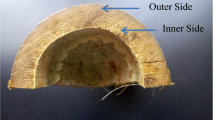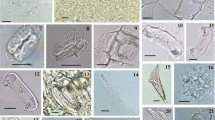Abstract
Phytoliths (siliceous structures) present in the plants have been employed in the fields of taxonomy and archaeology for many decades. Rostraria cristata is an economically important grass species (Poaceae) which accumulates silica in its different organs in the form of phytoliths. In order to understand the pattern of phytolith production and biochemical architecture of silica in R. cristata, leaf epidermis (blade) using the clearing solution method and different organs using the dry ashing method, X-ray diffraction and Fourier-transform infrared spectroscopy techniques were analyzed. Both abaxial and adaxial leaf epidermis showed the presence of acute bulbosus, rectangular sinuate and stomata phytolith morphotypes. Leaf including sheath and blade had the highest silica content. Characteristic phytolith morphotypes were present in different organs. A total of 34 phytolith morphotypes were present among which nine (9) were articulated and 25 were isolated forms. The most abundant were elongate scrobiculate (48.20%) in root and rectangular sinuate (26.16%) in leaf part. Other common phytolith morphotypes present in different organs of R. cristata were articulated elongate irregular, articulated elongate scrobiculate, acute bulbosus, and polygonal rondel etc. Leaf and synflorescence had the highest similarity based on presence/absence of phytolith morphotypes (Jaccard’s similarity index). XRD studies revealed the presence of cristobalite, quartz, tridymite, zeolite etc. forms of silica in different organs. FTIR spectra showed that inplane stretching vibration of Si–C was unique to root, anti-symmetric stretching vibration of C–H was unique to leaf and Al2O3.SiO2 was found in synflorescence only. Our results show the characteristic pattern of phytoliths production in R. cristata.









Similar content being viewed by others
Data availability
Data generated or analyzed during this study are provided in full within the published article and its supplementary materials.
References
Adel EG, El-Ghani M, Shalabi L (2013) Taxonomic significance of Glume morphology and leaf epidermal characteristics in some taxa of tribe Aveneae (Poaceae). Not Sci Biol 5:144–155. https://doi.org/10.15835/nsb528338
Anala R, Nambisan P (2015) Study of morphology and chemical composition of phytoliths on the surface of paddy straw. Paddy Water Environ 13:521–527. https://doi.org/10.1007/s10333-014-0468-5
Badgal P, Chowdhary P, Bhat MA, Soodan AS (2022) Phytolith profile of Acrachne racemosa (B. Heyne ex Roem. & Schult.) Ohwi (Cynodonteae, Chloridoideae, Poaceae). PLoS One 17:e0263721. https://doi.org/10.1371/journal.pone.0263721
Ball TB, Ehlers R, Standing MD (2009) Review of typologic and morphometric analysis of phytoliths produced by wheat and barley. Breed Sci 59:505–512. https://doi.org/10.1270/jsbbs.59.505
Ball TB, Davis A, Evett RR, Ladwig JL, Tromp M, Out WA, Portillo M (2016) Morphometric analysis of phytoliths: recommendations towards standardization from the International Committee for Phytolith Morphometrics. J Archaeol Sci 68:106–111. https://doi.org/10.1016/j.jas.2015.03.023
Beche D, Gebeyehu G, Feyisa K (2016) Indigenous utilization and management of useful plants in and around Awash National Park, Ethiopia. J Plant Biol Soil Health 3:1–12
Bhat MA, Shakoor SA, Badgal P, Soodan AS (2018) Taxonomic demarcation of Setaria pumila (Poir.) Roem. & Schult., S. verticillata (L.) P. Beauv., and S. viridis (L.) P. Beauv. (Cenchrinae, Paniceae, Panicoideae, Poaceae) from phytolith signatures. Front Plant Sci 9:864. https://doi.org/10.3389/fpls.2018.00864
Carnelli AL, Madella M, Theurillat JP (2001) Biogenic silica production in selected alpine plant species and plant communities. Ann Bot 87:425–434. https://doi.org/10.1006/anbo.2000.1355
Carnelli AL, Theurillat JP, Madella M (2004) Phytolith types and type-frequencies in subalpine–alpine plant species of the European Alps. Rev Palaeobot Palynol 129:39–65. https://doi.org/10.1016/j.revpalbo.2003.11.002
Clarke J (2003) The occurrence and significance of biogenic opal in the regolith. Earth Sci Rev 60:175–194. https://doi.org/10.1016/S0012-8252(02)00092-2
Dabney C, Ostergaard J, Watkins E, Chen C (2016) A novel method to characterize silica bodies in grasses. Plant Methods 12:1–10. https://doi.org/10.1186/s13007-016-0108-8
Ellis R (1977) Leaf anatomy of the South African Danthonieae (Poaceae). I. The genus Dregeochloa. Bothalia 12:209–213
Fernández Honaine M, Osterrieth ML (2012) Silicification of the adaxial epidermis of leaves of a panicoid grass in relation to leaf position and section and environmental conditions. Plant Biol 14:596–604. https://doi.org/10.1111/j.1438-8677.2011.00530.x
Fernández Honaine M, Benvenuto ML, Borrelli NL, Osterrieth M (2016) Early silicification of leaves and roots of seedlings of a panicoid grass grown under different conditions: anatomical relations and structural role. Plant Biol 18:1025–1030. https://doi.org/10.1111/plb.12488
Gao G, Jie D, Wang Y, Liu L, Liu H, Li D, Li N, Shi J, Leng C (2018) Do soil phytoliths accurately represent plant communities in a temperate region? A case study of Northeast China. Veg Hist Archaeobot 27:753–765. https://doi.org/10.1007/s00334-018-0670-2
Ge Y, Lu H, Zhang J, Wang C, He K, Huan X (2018) Phytolith analysis for the identification of barnyard millet (Echinochloa sp.) and its implications. Archaeol Anthropol Sci 10:61–73. https://doi.org/10.1007/s12520-016-0341-0
Gu Y, Pearsall DM, Xie S, Yu J (2008) Vegetation and fire history of a Chinese site in southern tropical Xishuangbanna derived from phytolith and charcoal records from Holocene sediments. J Biogeogr 35:325–341. https://doi.org/10.1111/j.1365-2699.2007.01763.x
Holm JL, Kleppa OJ, Westrum EF Jr (1967) Thermodynamics of polymorphic transformations in silica. Thermal properties from 5 to 1070 K and pressure-temperature stability fields for coesite and stishovite. Geochim Cosmochim Acta 31:2289–2307. https://doi.org/10.1016/0016-7037(67)90003-8
Jattisha PI, Sabu M (2015) Foliar phytoliths as an aid to the identification of Paniceae (Panicoideae: Poaceae) grasses in South India. Webbia 70:115–131. https://doi.org/10.1080/00837792.2015.1005908
Kealhofer L, Huang F, DeVincenzi M, Kim MM (2015) Phytoliths in Chinese foxtail millet (Setaria italica). Rev Palaeobot Palynol 223:116–127. https://doi.org/10.1016/j.revpalbo.2015.09.004
Khan A, Ullah I, Khan SU, Zhang K, Muhammad Z, Wazir SM, Ullah F, Shah S, Kang L, Ullah M (2018) Elemental and nutritional values of wild fodder plants of Poaceae in District Bannu, Pakistan. Int J Agronomy Agric Res 13:53–61
Kumar S, Elbaum R (2018) Interplay between silica deposition and viability during the life span of sorghum silica cells. New Phytol 217:1137–1145. https://doi.org/10.1111/nph.14867
Kumar S, Soukup M, Elbaum R (2017) Silicification in grasses: variation between different cell types. Front Plant Sci 8:438. https://doi.org/10.3389/fpls.2017.00438
Kumar S, Natalio F, Elbaum R (2021) Protein-driven biomineralization: comparing silica formation in grass silica cells to other biomineralization processes. J Struct Biol 213:107665. https://doi.org/10.1016/j.jsb.2020.107665
Lanning FC, Eleuterius LN (1985) Silica and ash in tissues of some plants growing in the coastal area of Mississippi, USA. Ann Bot 56:157–172. https://doi.org/10.1093/oxfordjournals.aob.a087000
Lanning FC, Ponnaiya BW, Crumpton CF (1958) The chemical nature of silica in plants. Plant Physiol 33:339–343
Li R, Carter JA, Xie S, Zou S, Gu Y, Zhu J, Xiong B (2010) Phytoliths and microcharcoal at Jinluojia archeological site in middle reaches of Yangtze River indicative of paleoclimate and human activity during the last 3000 years. J Archaeol Sci 37:124–132. https://doi.org/10.1016/j.jas.2009.09.022
Lisztes-Szabó Z, Braun M, Csík A, Pető Á (2019) Phytoliths of six woody species important in the Carpathians: characteristic phytoliths in Norway spruce needles. Veg Hist Archaeobot 28:649–662
Ma JF, Yamaji N (2006) Silicon uptake and accumulation in higher plants. Trends Plant Sci 11:392–397. https://doi.org/10.1016/j.tplants.2006.06.007
Madella M, Alexandre A, Ball T (2005) International code for phytolith nomenclature 1.0. Ann Bot 96:253–260. https://doi.org/10.1093/aob/mci172
Morris RV, Vaniman DT, Blake DF, Gellert R, Chipera SJ, Rampe EB, Ming DW, Morrison SM, Downs RT, Treiman AH, Yen AS (2016) Silicic volcanism on Mars evidenced by tridymite in high-SiO2 sedimentary rock at Gale crater. Proc Natl Acad Sci 113:7071–7076. https://doi.org/10.1073/pnas.1607098113
Mulholland SC (1989) Phytolith shape frequencies in North Dakota grasses: a comparison to general patterns. J Archaeol Sci 16:489–511. https://doi.org/10.1016/0305-4403(89)90070-8
Naskar M, Bera S (2018) Taxonomic assessment of opal phytoliths from grasses of deltaic West Bengal, India. Nord J Bot 36:1–42. https://doi.org/10.1111/njb.01695
Neumann K, Strömberg CA, Ball T, Albert RM, Vrydaghs L, Scott Cummings L (2019) International code for phytolith nomenclature (ICPN) 2.0. Ann Bot 124:189–199. https://doi.org/10.1093/aob/mcz064
Out WA, Madella M (2017) Towards improved detection and identification of crop by-products: morphometric analysis of bilobate leaf phytoliths of Pennisetum glaucum and Sorghum bicolor. Quat Int 434:1–14. https://doi.org/10.1016/j.quaint.2015.07.017
Out WA, Mieth A, Pla-Rabés S, Madella M, Khamnueva-Wendt S, Langan C, Dreibrodt S, Merseburger S, Bork HR (2021) Prehistoric pigment production on Rapa Nui (Easter Island), c. AD 1200–1650: New insights from Vaipú and Poike based on phytoliths, diatoms and 14C dating. Holocene 31:592–606. https://doi.org/10.1177/0959683620981671
Piperno DR (2006) Phytoliths: a comprehensive guide for archaeologists and paleoecologists. Rowman Altamira
Portillo M, Ball T, Manwaring J (2006) Morphometric analysis of inflorescence phytoliths produced by Avena sativa L. and Avena strigos Schreb. Econ Bot 60:121–129
Rovner I (1971) Potential of opal phytoliths for use in paleoecological reconstruction. Quat Res 1:343–359. https://doi.org/10.1016/0033-5894(71)90070-6
Saikia K, Paruya DK, Ghosh R, Bera S (2022) Phytolith assemblages of Shorea robusta Gaertn. (Sal) from West Bengal part of the Bengal Basin, India and their implications in palaeoclimate reconstructions. Bot Lett 169:127–139. https://doi.org/10.1080/23818107.2021.1960602
Shakoor SA, Bhat MA, Soodan AS (2016) Taxonomic demarcation of Arundo donax L. and Phragmites karka (Retz.) Trin. ex Steud. (Arundinoideae, Poaceae) from phytolith signatures. Flora 224:130–153. https://doi.org/10.1016/j.flora.2016.07.011
Wallis L (2003) An overview of leaf phytolith production patterns in selected northwest Australian flora. Rev Palaeobot Palyno 125:201–248. https://doi.org/10.1016/S0034-6667(03)00003-4
Yost CL, Blinnikov MS (2011) Locally diagnostic phytoliths of wild rice (Zizania palustris L.) from Minnesota, USA: comparison to other wetland grasses and usefulness for archaeobotany and paleoecological reconstructions. J Archaeol Sci 38:1977–1991. https://doi.org/10.1016/j.jas.2011.04.016
Zancajo VM, Diehn S, Filiba N, Goobes G, Kneipp J, Elbaum R (2019) Spectroscopic discrimination of Sorghum silica phytoliths. Front Plant Sci 10:1571. https://doi.org/10.3389/fpls.2019.01571
Zhang J, Lu H, Wu N, Yang X, Diao X (2011) Phytolith analysis for differentiating between foxtail millet (Setaria italica) and green foxtail (Setaria viridis). PLoS One 6:e19726. https://doi.org/10.1371/journal.pone.0019726
Acknowledgements
The authors are thankful to the Department of Chemistry, Guru Nanak Dev University, Amritsar for providing instrumentation facility for FTIR and XRD analysis.
Funding
This research received no specific grant from any funding agency.
Author information
Authors and Affiliations
Contributions
PC and ASS conceived and designed the experiments. PC performed the experiments. PC and MAB contributed to the sample collection. PC, PB and SAS contributed in data analysis. PC wrote the manuscript. ASS and BAM supervised the work. All the authors discussed the results and commented on the manuscript. The authors read and approved the final manuscript.
Corresponding authors
Ethics declarations
Conflict of interest
The authors declare that they have no competing interests.
Additional information
Publisher's Note
Springer Nature remains neutral with regard to jurisdictional claims in published maps and institutional affiliations.
Supplementary Information
Below is the link to the electronic supplementary material.
Rights and permissions
Springer Nature or its licensor (e.g. a society or other partner) holds exclusive rights to this article under a publishing agreement with the author(s) or other rightsholder(s); author self-archiving of the accepted manuscript version of this article is solely governed by the terms of such publishing agreement and applicable law.
About this article
Cite this article
Chowdhary, P., Badgal, P., Bhat, M.A. et al. Phytoliths analysis in root, culm, leaf and synflorescence of Rostraria cristata (Poaceae). J Plant Res 136, 787–801 (2023). https://doi.org/10.1007/s10265-023-01485-1
Received:
Accepted:
Published:
Issue Date:
DOI: https://doi.org/10.1007/s10265-023-01485-1




